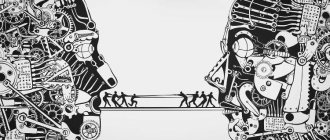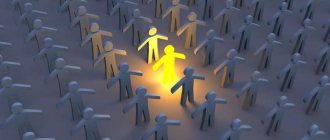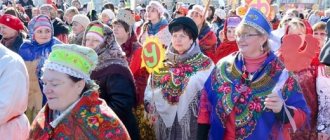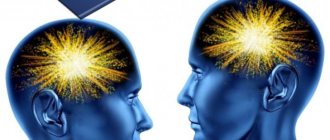Crowd psychology studies the differences between the behavior of individuals in a mass gathering of people and in relative solitude. This section of social psychology is relevant for study, since mass gatherings of people can be dangerous and unpredictable.
A crowd is an organism that has a heart, rhythm, and breathing. When a large group of people is driven by one emotion, one goal, it is almost impossible to manage it. Crowd behavior attracts attention not only because of its characteristics, but also because of the risk of injury. History knows many cases when people were trampled to death in a large crowd of people.
What are the features of crowd psychology, what are its signs and structural characteristics, types and methods of control - we will understand in this article.
Essence of the Crowd
I will refer to the work of Mikhail Litvak.
Studying his work, I can say that the crowd is a universal tool that can be controlled. Since crowds are a collection of people, it means they have their own purpose. This is one of the characteristics of a crowd. There is a merging of individuals into a single mind and feelings, which reduce intellectual abilities. That is, a person’s personality disappears. The state of a person in a crowd changes very much. His consciousness, having lost activity, allows him to enter a state of darkness, give in to panic or temptation.
And so, to form a crowd, it is not reason that is needed, but faith. There are no crowds without beliefs.
“When human reason takes over, the crowd scatters. In a crowd, a person acts not in accordance with his experience, but in accordance with the opinion of the majority or the leader.” – writes Litvak. But this is so. We can take a football team of fans as an example. They have various slogans that they shout to support their favorite team. For example, a crowd of five people shouts a slogan, and then other crowds or individuals begin to join them. And a moment later this slogan is shouted by half the stadium. The so-called “infection” occurs.
The crowd is very fickle. This can be seen in the transition from the bloodiest ferocity to heroism. But, unfortunately, crowds are more capable of sacrifices and inappropriate actions than an individual.
Psychological properties of the crowd
Social psychologists have noted a number of psychological characteristics of crowds. They are inherent in the entire psychological structure of this education and manifest themselves in different areas:
- informative;
- emotional-volitional;
- temperamental;
- morality.
In the cognitive sphere, the crowd expresses various oddities in its psychology.
Incapacity for consciousness. The main psychological characteristics of the crowd are its unconsciousness, instinctiveness and impulsiveness. If even one person is very poorly accessible to the messages of reason, and therefore performs most of his actions in life on the basis of emotional, sometimes completely blind impulses, then the crowd lives exclusively by feelings, logic is against it. The uncontrollable herd instinct comes into play, especially in an extreme situation, when there is no leader and no one shouts restraining command words. The heterogeneous in each of the individuals, part of the crowd, is immersed in the homogeneous, and unconscious traits take over. Common traits, driven by the unconscious, gather into a crowd. An isolated individual has the ability to suppress unconscious reflexes, while a crowd does not have this ability.
Features of imagination. The crowd has a highly developed capacity for imagination. The crowd is very receptive to impressions. The images that capture the imagination of viewers are always simple and understandable. The pictures that someone creates in the imagination of the spectators, the imagination of an event or incident, are almost as vivid as real pictures. It is not the facts themselves that excite the imagination of the crowd, but the way they are presented to them. Another very important crowd effect is collective hallucinations. In the imagination of people gathered in a crowd, events are distorted.
Features of thinking. The crowd thinks in images, and the image evoked in its imagination evokes in turn others that have no logical connection with the first. The crowd does not separate the subjective from the objective. He considers as real the images evoked in his mind, which often have only a very distant connection with the fact that he observes. The crowd, which can think only in images, is receptive only to images. The crowd does not think or reflect. He accepts or completely rejects ideas. He does not tolerate disputes and contradictions. People's reasoning is based on associations, but they are connected only by apparent analogy and consistency. The crowd can only accept ideas that are simplified to the extreme. People's judgments are always imposed on them and are never the result of careful discussion. The crowd never strives for the truth. They turn away from evidence that they do not like, and prefer to worship mirages and illusions when they only attract. To a crowd that can neither think nor reason, nothing is incredible, but it is the incredible that stands out the most. There are no resolutions in the crowd. He may constantly experience and go through the whole gamut of conflicting feelings, but will always be influenced by the excitement of the moment. The combination of disparate ideas that have only an apparent relation to each other and the immediate generalization of specific cases are characteristic features of crowd thinking. The crowd is constantly under the influence of illusions. It is worth emphasizing some important features of the crowd mentality.
Categorical. Having no scruples about what is true and what is false, the crowd expresses in its judgments as much authority as intolerance. Conservatism. At its core, the mafia is extremely conservative, has a deep aversion to all innovations and has an unlimited respect for traditions.
General crowd classification
There are several classifications of crowds, such as:
- Spontaneous crowd - Formed and manifested without any organizing principle on the part of a specific individual.
- Driven crowd - Formed and manifested under the influence, influence from the very beginning or subsequently of a specific individual who is its leader in a given crowd.
- Occasional crowd - Formed on the basis of curiosity about an unexpected incident, for example a traffic accident
- Conventional crowd - Formed on the basis of interest in some pre-announced mass entertainment, spectacle or other socially significant specific occasion.
- Expressive crowd - Formed like a conventional crowd. It jointly expresses the general attitude towards an event, for example a protest.
- Ecstatic crowd - They are an extreme form of expressive crowd. It is characterized by a state of general ecstasy based on mutual, rhythmically increasing “infection”, for example rituals.
The main system-forming feature of a crowd is its spontaneity.
Basic Crowd Characteristics
And so, let's note some signs of a crowd.
Changeability
The crowd can't contain their emotions.
Because of this, she tends to move from bloodthirstiness to heroism.
The crowd has its own world, which goes towards its goal or desire, it does not see barriers. She does not understand the words that make her give up her desire. The crowd understands the promises. “If the crowd wants the moon, you have to promise them the moon,” was the example Litvak gave.
Merger
The crowd is constantly in attention, thereby infecting individuals; the larger it is, the more it infects.
Authoritarianism and conservatism
Because the crowd constantly goes to extremes, it can either accept the entire idea and treat it as absolute truth, or reject it completely. The crowd cannot analyze; it has no doubts. Therefore, the crowd is authoritarian and intolerant. The slightest disagreement of the speaker causes rage and leads to his expulsion.
Types of Crowds
Attempts to make a comprehensive classification of crowds have been made repeatedly since Le Bon's work. But so far such a classification does not exist. The fact is that the same crowd contains many different signs and characteristics. Can be simultaneously:
- aggressive and fleeing;
- conventional (united by a common interest) and expressive.
Therefore, there are several classification options for different reasons.
By degree of activity
There are 2 types of crowds based on this criterion: passive and active.
- Passive crowds have low levels of emotionality and arousal. Of all the psychological characteristics, this type is characterized only by mass character, and in the full sense of the word, such gatherings of people are not crowds. These include, for example, people sightseeing, meeting, seeing off and waiting for a train at the station, transport crowds in the subway, etc. But in the event of some emotional event, these crowds quickly cease to be passive.
- An active crowd is in a state of emotional excitement, so it develops a readiness for joint action.
By the nature of emotionality
The crowd is always filled with emotions, but they are of a different nature, which affects the characteristics of the actions of this spontaneous group:
- An enthusiastic or ecstatic crowd unites people on the basis of positive emotions that are caused by a common spectacle (concert, festival) or a common action (religious ceremonies and cults, carnivals, etc.).
- A panicked crowd occurs under the influence of a strong feeling of fear, which develops into panic. This emotional state leads to a rapid loss of rational control. Controlling a panicked crowd is almost impossible.
- An aggressive crowd is characterized by a high degree of mental stress and negative emotions: hatred, despair, frustration. The occurrence of aggression is always associated with some stimulus, for example, a rumor, information dumping, that is, a phenomenon that causes general indignation.
According to the degree of spontaneity
Although the crowd belongs to spontaneous large groups, the degree of this spontaneity can vary.
- Organized crowd. This type was described by G. Lebon using the example of mass protests by workers at rallies and strikes. It is distinguished by purposeful organization and controls, and often even a clear plan of action. Its instigators formulate it and involve their supporters from among the crowd in its implementation.
- Driven crowd. More often it forms spontaneously, but thanks to a person or group of people with leadership abilities it takes on the characteristics of being organized.
There are other grounds on which crowds can be classified, but these are the most basic and generally accepted.
Methods and characteristics of crowd studies. Crowd behavior
We know that the crowd is endowed with extremism. For its existence, a single faith is needed. Crowds are also not resistant to fluctuations; doubts lead to the risk of their fragmentation. Because of this, she tries to get rid of doubts and uncertainties, in which speakers help her. Speakers hammer into the crowd exaggerated judgments. Maintaining stability.
Another feature of crowd behavior is Illusion, which is created from the opinions of others, false information appears, it can deceive the senses.
Communication in a Crowd
When a crowd is formed, communication takes on serious importance. In a crowd it is an exchange of important information. It is known that a person participates in mass actions if he becomes infected with the visible behavior of others, or if he learns about it through information channels. Certain types of such behavior appear due to an acute lack of data or an ineffective information delivery system.
A person is ready to succumb to the contagious action of the crowd if this action coincides with his beliefs. In society, along with official communication, informal communication works. They touch at different points. Unofficial sources include rumors and gossip. They move to the pages of the media.
Factors influencing crowds
An important factor in crowds is race. She needs to constantly maintain intellectual connectedness and emotional persuasion. Race has the power to transform ideas or needs into traditions. From here she is able to transmit these traditions to another race.
“People of all races worship one deity, calling him by different names - hope. After all, all their gods were one and only god,” wrote Le Bon. Litvak believes that hope must be killed. I agree with him, because when there is no hope, a person will listen to reason.
Another important factor is the use of formulas and certain words. The more vague the word or expression, the greater the influence. Words such as equality, socialism, democracy, freedom are perceived by the crowd as if the solution to all problems depends on them
Spiritual unity
Many researchers whose subject of study is the psychology of the masses agree that the crowd is an unorganized society. Its main characteristic has always been spiritual unity. In this case, it can be compared to something like a highly contagious infectious disease. The main “symptom” of the disease is a state of passion, which, at the time of a strong emotional outburst, spreads at high speed.
As an exception that confirms the above rule, we can consider a crowd that was formed as a result of the unification of people who have a similar way of thinking. Only like-minded people will be able to integrate, and not all those who have been infected by a common emotional state.
A feature of any group, especially an aggressive one, is categorical beliefs and conservatism. They can also be regarded as the foundation for spiritual unity. Based on the fact that the crowd is absolutely confident in the correctness of the line drawn between truth and error, it is characterized by intolerance.
How to control a crowd
“A person should strain his mind even less: he just needs to look through and read the shortest texts,” Hitler wrote. Words evoke mental images, but also powerful visual images. At first there was an increase in the expressiveness of words due to radio, then the generation of images due to cinema and television.
The means of communication have undergone evolution. And first of all, unwanted people should be removed from television. And there are even fewer radio listeners and reading public. The means of communication have made automatic thinking a historical factor. And this factor will exist as long as the crowd exists.
In order to control a crowd you need a leader or a leader. But how should a leader inspire confidence in order to move the crowd and assert his influence over it? Litvak wrote that two paths are closed to the Leader: strength and reason. I completely agree with him, since force guarantees submission through fear, the mind is also not suitable, because the masses are insensitive to rational evidence. All that remains is seduction or seduction. It's like hypnosis, it takes the crowd away from its reality, more beautiful, corresponding to its hopes. The leader’s temptation is not to try to hide himself, but rather acts openly.
And to seduce in this way means to transfer the crowd from the rational world to the world of illusions.
Most likely you will think that leaders or leaders are deceivers. In fact, they themselves are in the grip of this illusion.
It is necessary for a leader to be like an actor. First of all, it is necessary to turn individuals into a crowd and involve them in certain activities. Scientists point out that techniques are always specific, but three strategies are always the same: presentation - controls space, ceremony - controls time, and persuasion - controls words.
In order for a crowd to gather, they need space, then each individual feels stronger and supported by the masses.
After which a meeting should be held. In it, the leader uses all his authority. This drives the collective fusion to its highest point. Without demonstrations, military processions, and congresses there cannot be crowds.
The ceremony brings the crowd together well, contributes to the dissolution of the individual in the mass, as well as the automatic adoption of behavior.
The speaker also plays an important role. A speaker, for example, who wants to captivate a crowd must abuse strong expressions. Exaggerating, asserting, repeating and never trying to prove anything by reasoning are the methods of argumentation for the crowd.
Conclusion
I examined some problems of crowd psychology in their theoretical and practical aspects. The main practical question that interests society and especially law enforcement agencies is: how to ensure control over crowd behavior? - remains unanswered. The most reasonable conclusion that scientists have come to is one thing: to prevent the emergence of such a phenomenon as an aggressive crowd. When our society copes with this, the crowd problem will disappear and will not require the intervention of either the police or science.
On the one hand, man is an exclusively social “animal”. On the other hand, this is a person’s weakness, because... our consciousness constantly adapts to the actions of the majority.
In order to prevent the emergence of such a phenomenon as an aggressive crowd, it is first necessary to eliminate long-term conditions that create feelings of social dissatisfaction, dissatisfaction, despair, and hopelessness.
If any events occur that could provoke the appearance of an aggressive crowd or a crowd begins to gather, then it is necessary to take urgent informational, organizational and tactical measures to prevent the concentration of a large number of people in one place. In particular, it is necessary to at least temporarily isolate informal leaders and instigators of unrest from people and involve people who could positively influence the crowd.
However, if we still have to “deal” with an aggressive crowd, then the following recommendations are useful:
- do not take any measures to influence the crowd, do not under any circumstances try to squeeze it or force it out of its place;
- block approaches to the crowd, preventing its replenishment, stall for time - it works against the crowd - people get tired and their activity decreases;
- eliminate emotions, do not respond to insults, show restraint; this is due to the fact that impulsiveness is characteristic of a person in a crowd and of the crowd as a whole;
- you should not enter into conversations with people - you should limit yourself to the answer: “We are following the order”; this is due to the fact that people in the crowd, due to the predominance of emotions, have a lower level of intelligence and it is pointless to prove anything to them;
- strictly follow orders from management;
- do not let people near you unless necessary;
- constantly (through speech amplification devices) inform people about exit corridors, responsibilities, and measures taken to eliminate the reasons why the crowd has gathered;
- people should not be prevented from leaving the crowd, but only through the indicated exit corridors, where filtration points should be organized;
- people should be invited to select a group from among themselves for negotiations;
- specially selected and trained senior officers must be used to communicate with the crowd and conduct negotiations;
- Negotiations should be conducted without interruption.
Sources used
- Lebon G. “Psychology of Peoples and Masses” - ed. “Maket”, St. Petersburg, 1995.
- Mikhail Litvak “To command or to obey?” — 26th edition, “Phoenix” 2015.
- Fofoi. [Electronic resource].
- Psychofactor. [Electronic resource].
- Wikipedia. [Electronic resource].
- Wikipedia. [Electronic resource].
- 2health. [Electronic resource].
Application. A reminder of the rules of behavior in a crowd
- Do not take any measures to influence the crowd, do not under any circumstances try to squeeze them or force them out of their place;
- You should not enter into conversations with people - you should limit yourself to the answer: “We are following the order”;
- Accurately follow orders from management;
- Specially selected and trained senior officers must be used to communicate with the crowd and conduct negotiations;
- Negotiations should be conducted without interruption.
- Blocking approaches to the crowd, preventing it from replenishing, stalling for time - it works against the crowd - people get tired and their activity decreases;
- Eliminate emotions, do not respond to insults, show restraint; this is due to the fact that impulsiveness is characteristic of a person in a crowd and of the crowd as a whole;
- You should not enter into conversations with people - you should limit yourself to the answer: “We are following the order”; this is due to the fact that people in the crowd, due to the predominance of emotions, have a lower level of intelligence and it is pointless to prove anything to them.
If you liked the page, share it on social networks:
Psychology of the crowd. Mass consciousness and behavior.
Generalization of the achievements of modern scientific analysis of the problem of mass political behavior allows, within the framework of political psychology, to identify the most significant features of this phenomenon. Mass spontaneous behavior (English, colecive behavior) is a term of political psychology that denotes various forms of crowd behavior, the circulation of rumors, panic and other mass phenomena. First of all, it should be noted that its character and direction depend and are determined by mass consciousness. Mass behavior , of course, is affected by the determining role of mass consciousness , which is understood as a reflection of the material conditions of life, work and relationships. At the same time, mass consciousness is considered the core of all the noted components and has a number of features: • it is derived, first of all, from the economic basis of society and in content covers all its socio-political and economic problems; • has a multifaceted systemic nature, ensuring the integration of various forms of consciousness - legal, ethnic, political, professional, spontaneous, etc.; • manifests itself at three levels - individual (individual), group (small groups) and holistic (public); • plays an active transformative role in behavior and relationships. Mass consciousness , as an integrative determinant of mass behavior, has a number of features - high dynamism, inconsistency and spontaneity, as it is formed and changes under the influence of a wider and more mobile range of factors; significantly depends on the stability of the integration of various actually operating factors and conditions; manifests itself ambiguously and contradictorily at the individual, group and mass levels. The crowd is considered by political psychology as a multitude of people who are not connected by a common goal and a single positional-role organization, but are united by a common center of attention, similarity of emotional state and, to some extent, exhibiting mass consciousness. A crowd is a type of social organism. In terms of the nature of feeling and behavioral response, it differs significantly from an organized group and requires radically different mechanisms, techniques and management skills. At the same time, the differences between a crowd and a group are not discrete: between the extreme poles there are many intermediate states. In particular, a concentrated mass of people usually acquires some of the properties of a crowd, while retaining the qualities of an organized group. The reasons and immediate reasons for arousing discontent or enthusiasm of the crowd can be very diverse and not necessarily political: from increased solar activity to the depreciation of the national currency. Researchers emphasize that in a crowd a person feels anonymous, which pushes him to take more risky and irresponsible actions. These actions may be heroic, but violence, vandalism and hooliganism are just as likely. The irrationality of actions is explained by the herd feeling, which allows individual participants to turn off their will, consciousness and act according to the laws of the crowd. The crowd as a type of social group is characterized by amorphous, homogeneous structure. There is either no leader at all, or, if one appears (and this often happens due to self-appointment), then all group members are divided into two roles: the leader and his followers. At the same time, the leader’s power is unlimited, since his followers do not think, but blindly follow his orders. Mechanisms of crowd formation : rumors and circular reaction. Hearing is the process of transmitting emotionally relevant information through means of communication. Circular reaction (synonym: emotional whirling) is a process of mutual infection, as it intensifies, the interaction between individuals drops from the semantic (communication) to the psychophysiological level.
Crowd types
A large number of observations and psychological studies of mass spontaneous behavior made it possible to derive the following conditional classification. Occasional crowd (from English, occasion - case) - a lot of people (onlookers) who have gathered about an unexpected street incident. The dominant emotion is curiosity. A sequential crowd (from English, convention - convention) gathers on the occasion of a pre-announced event: a rally, a rock band concert, a football match, etc. More organized interest prevails here, and people for the time being (while retaining the qualities of a conventional crowd) ready to follow certain conventions. A more directed interest dominates here. An expressive crowd (from English, expression - expression), rhythmically expressing one or another emotion: joy, enthusiasm, protest, etc. The dominant emotions here can be different, the main characteristic is the rhythm of expression. An ecstatic crowd (from English, ecstasy) is an extreme form of an expressive crowd. People who have reached ecstasy selflessly torture themselves with chains, tear their clothes, dance until exhaustion, sometimes fatal, unable to stop, etc. The active crowd is the most dangerous variety, within which the following subspecies can be distinguished: : - aggressive crowd . The dominant emotion is rage, anger towards the object; - panic crowd . Dominant - fear, horror, the desire for everyone individually to avoid real or imaginary danger; - acquisitive crowd - people who entered into an unorganized conflict over the possession of some value. Dominant - greed, thirst for acquisition. In specific situations it may be accompanied by fear, anger or adoration; — an insurrectionary crowd is similar to an aggressive crowd in a number of ways, but differs from it in the socially just nature of its indignation. In practice, this is expressed by the fact that if there is an active organizing link, an organizational principle can be introduced into the insurgent crowd. There are cases where a rebel crowd was eventually able to be organized into an effective group. Solidarity is also one of the instinctive forms of behavior of participants in mass events, who are capable of not only competing with each other, but also collaborating. The manifestation of solidarity in politics is based on the identification of people with a certain part of the crowd, a group, which allows them to unite the efforts of some of the participants to achieve their goals and interests. Without describing the numerous forms of manifestation of instincts in politics, we note that in general instincts cover all unconscious, irrational, sensual forms of behavior of both an individual in a crowd and organized groups, spontaneous actions of the masses. It was possible to identify four sets of prerequisites (factors) for the transformation of a more or less organized group into a panicked crowd. Social preconditions - general tension in society caused by natural, economic or political disasters: earthquakes, floods, a sharp drop in the exchange rate, the start or failure of hostilities, etc. Physiological preconditions - fatigue, hunger, prolonged insomnia, the effects of alcohol, drugs . At the same time, the level of individual self-control decreases, which in large crowds of people is fraught with especially dangerous consequences. General psychological prerequisites - surprise, fear, caused by insufficient awareness of the probable danger and possible methods of counteraction. Socio-psychological and ideological prerequisites are the lack of a clear and highly significant common goal, effective leadership, insufficient trust in leaders and a low level of group cohesion.
| 23.Politics as science and art |
| Politics can be considered both a science and an art. The main task of politics as a science is to determine the goals and objectives of political development, development, modeling and forecasting of various aspects of political activity. Politics has the right to be considered as a science in the sense that it can serve as a source of knowledge about one of the vital spheres of existence of people, classes, parties and states. But politics itself must be built on the basis of relevant scientific knowledge and take into account the results of the objective laws of social development, with the presence of certain social mechanisms, principles and norms regulating the development of the social organism. Making political decisions in modern democratic systems requires comprehensive scientific expertise, a system of consultations, and professional relations. Politics is always the result of the painstaking, time-consuming work of politicians, research centers and scientific institutions, a consequence of the collective mind of many people and organizations. However, there cannot be complete identity of science and politics, just as theory and practice cannot be identical. This is determined by the probabilistic nature of the political process, the presence of both rational and irrational principles in politics. Politics requires not only knowledge, but also the skill of political maneuvering and compromise, the ability to captivate and lead the masses, the ability to adequately respond to a rapidly changing situation, and anticipate the course of political events. Not everything in politics lends itself to naked calculation; it also contains emotions, intuition, and skill. Therefore, politics is not only a science, but also an art - the art of governing the state, the art of gaining and maintaining power, and implementing various social goals and interests. There is an opinion that politics is the art of the possible. The political leader is limited in his activities by available resources; it must take into account the balance of forces, public opinion, the state of political culture and a number of other factors. The art of politics is to achieve a goal with minimal costs and losses |










